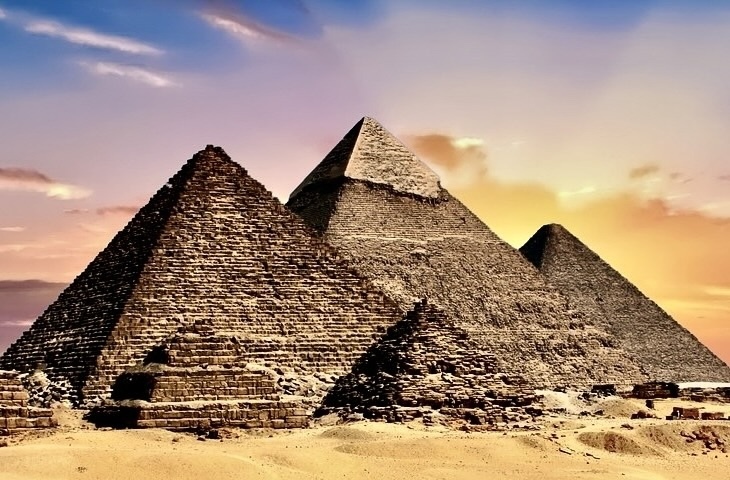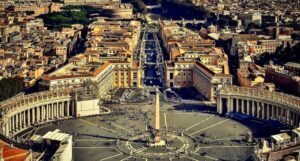
In Rome one finds the world’s most exquisite exclamation point: the towering obelisk which punctuates the symmetrical splendor and baroque beauty of St. Peter’s Square.
Climbing nearly a hundred feet into the Vatican sky, the reddish granite needle is surmounted by an iron cross which is said to contain a fragment of the True Cross. Thus Pope Sixtus V had these words engraved on the pedestal:
ECCE CRUCEM DOMINI
CHRISTUS VINCIT
CHRISTUS REGNATCHRISTUS IMPERAT
(Behold the Cross of the Lord. Christ Conquers,
Christ reigns, Christ rules.)
This is but one of twenty-two obelisks that were brought back from Egypt to Rome in Imperial times, thirteen of which have survived to our day. St. Peter’s Square’s great centerpiece, whose hieroglyphics sang the praises of King Menephta (1420-1400 B.C.), was transported from the banks of the Nile to the banks of the Tiber by order of Caligula. He used it to adorn the spina of the hippodrome in Ager Vaticanus – the Vatican meadows – where it became the mute witness to much spectacle and much savagery, including, perhaps, the crucifixion of the Apostle Peter.
______________________________
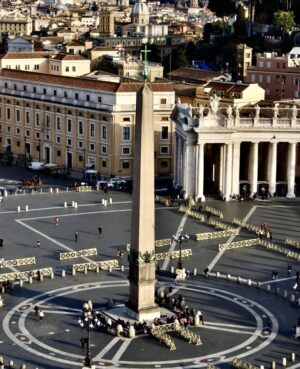
The obelisk in St. Peter’s Square. paterdarius, Pixabay
______________________________
Obelisks are tall, slender, monolithic quadrangular monuments that constitute a typical expression of Egyptian art: solar symbols. These stone shafts of Aswan granite gradually tapered to a pyramid-shaped apex and were often engraved on their flat sides with picture-writings exalting the deeds of this or that god or pharaoh. In Egypt, obelisks of varying dimensions stood – often in pairs – before the entrances to temples and palaces, and were considered sacred to the Sun.
Not content with the art treasures and other valuable booty which they had conveyed from all parts of the classical world to Rome, the emperors went so far as to have their thunderous conquering legions remove the multi-ton obelisks from the elegant pedestals, whereon they had majestically rested for centuries, and, no matter the enormously challenging difficulty, haul them over land and sea, to the city of the seven hills. All this was done to testify to the conquests of vaunted Roman arms, and, more importantly, to the emperors’ self-proclaimed greatness.
Augustus was the first to be charmed by these already ancient monuments and in 10 B.C. he confiscated two of them – one from the tomb of Ramses II (also known as Ramses the Great) who ruled as pharaoh from 1279 to 1213 B.C. in Heliopolis. The overseas transport of the first – 78 feet and 400 tons – proved to be a matter of such unprecedented difficulty that an immense ship with an extremely long, wide deck had to be designed and built expressly for that purpose. The herculean efforts of as many as three hundred oarsmen were required to propel this unique vessel with its recumbent cargo, ballasted by sandbags beyond count to prevent it from shifting and/or rolling over and sending itself and the ship to the depths of the Mediterranean. The last leg of the voyage had to be completed on land, thus halfway up the Tiber the hefty cargo had to be transferred to a trahea, a land vehicle called, in English, a sledge, mounted on two, maybe four, well-shaved smooth runners designed for transporting heavy loads over sand and soil and streets, and which was pulled via thick hemp-fiber ropes by many thousands of able-bodied men. There were massive crowds of on-lookers as the sledge was hauled into the city through the Ostian Gate of the Servian Walls. The proud and pleased Augustus ordered this war-prize to be installed on the spina of the Circus Maximus. He had coins and medals struck in commemoration of the various stages of the whole enterprise.
The second obelisk, 72 feet tall, was a millennium younger and paid tribute to Pammeticus II. Augustus had this one placed down in the heart of the Campus Martius to serve as a gigantic sun-dial. Pliny (XXXVI.15) informs us:
“Ei, qui est in Campo, divus Augustus
addidit mirabilem usum ad deprendendas solis
umbras dierumque ac noctium ita magnitudinis
strato lapide ad longitudinem obelisci,
cui par fieret umbra brumae confectae
die sexta hora … “
(That obelisk standing in the Campus was employed in
a remarkable way for the sake of gauging the shadows
of the sun and indicating the length of days and nights….)
By the way, both Augustan trophies took up new residences in Rome in the late 1700’s – the older in Piazza del Popolo, the younger on Monte Citorio in front of the Parliament building. The one in the piazza rises much higher these days; standing on a new base it stretches well over a hundred feet into the air and is surrounded by four lions – also brought back from Egypt – spouting water into travertine basins.
_____________________________
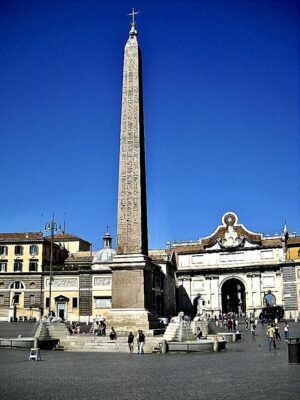
The obelisk still standing in the Piazza del Popolo in Rome. Gobbler, CC BY-SA 3.0, Wikimedia Commons
_____________________________
……….
In A.D. 40, Claudius had two more of these granite shafts shipped to Rome. This pair of two-thousand-year-old obelisks were set up to serve as ornaments for the Tomb of Augustus. There they stood as sentries flanking the mausoleum’s entrance and reaching forty–five feet in height.
In 1589, Pope Sixtus V put the renowned architect Domenico Fontana in charge of moving one of these to the summit of the Quirinal Hill, which was then cherished for its breathtaking panorama of the city, its soft air and cool breezes, prompting Sixtus to build a palace there to be used as a papal summer residence. In 1870 this property was seized by the King of the “New Italy” and declared the Royal Palace. Today’s post World War II Italy uses the splendid palazzo as the home of the nation’s (largely figurehead) president. On its new tall pedestal, and positioned above the huge Fountain of the Dioscuri (Horse Tamers) and capped with a cross, the obelisk stretches 95 feet into the Roman firmament. The fountain’s colossal statues representing the Gemini, Castor and Pollux, once graced the then nearby Baths of Constantine, says the inscription:
…E PROXIMIS CONSTANTINIANIS THERMIS…
The other monolith of the Augusteum was moved to its current location, on the Esquiline Hill, facing the rear of the apse of the Basilica of Santa Maria Maggiore. On its new base and crowned with a cross, it now climbs to a height of 82 feet.
_______________________________
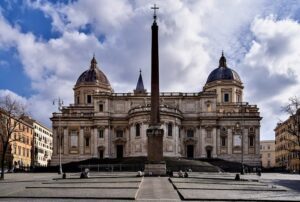
Basilica Santa Maria Maggiore, with the obelisk. CC BY-4.0, Wikimedia Commons
_______________________________
As the first century A.D. drew to a close, the Emperor Domitian of the Flavian Dynasty increased the city’s obelisk inventory by three, two of which were rather small as these things go (19 feet high). These adorned the Eternal City’s Temple of Isis and Serapis. (Yes, even the Egyptian religion found its way to Rome.) The third and largest one (51 feet high) Domitian had hauled up to his country villa in the Alban Hills. The villa still survives, but in ruins. (This area is now the delightful village of Castel Gandolfo.) In 1657 the architect Bernini had the obelisk carted down into the city where he re-erected it in Piazza Navona as the crowning glory of his spectacular Fountain of the Four Rivers.
A decade later, Bernini placed one of the two smaller Domitian trophies on the back of his beautifully carved elephant in the center of Piazza Minerva, where there had stood, in antiquity, a stately temple to that Roman goddess of wisdom and war. This site was an altogether fitting choice inasmuch as this little obelisk, and its twin, had stood in homage back home before the shrine of Neith, the Egyptian goddess of…wisdom and war. A fervent admirer of the ancient civilization and culture of the Pharaohs, Bernini was saying with his symbolism that “It would take the strength of an elephant to sustain the brilliance of the Egyptians.”
Just a block away we find the twin of this elephant-riding stele, in Piazza della Rotonda, so-called because of the round temple that anchors one end of the charming square, the ancient, virtually perfectly preserved, Pantheon which, as its Greek name suggests, honors all the gods of pagan Rome. The inscription on the base has this to say about the obelisk, which is wed to an endlessly splashing fountain:
CLEMENS XI PONT MAX
FONTIS ET FORI
ORNAMENTO
ANNO SAL MDCCXI
PONTIF XI
(Clement the Eleventh SUPREME PONTIFF gave
this as an ornament for the fountain
and the square in the year of Salvation 1711,
the eleventh year of his Pontificate)
_______________________________
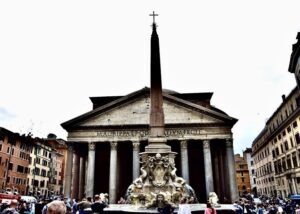
The Pantheon and the Fontana del Pantheon in Rome, with obelisk topping the famous fountain. Ank Kumar, CC BY-SA 4.0, Wikimedia Commons
_______________________________
Continuing the tradition of obelisk-collecting, Hadrian (117-138) brought home from his sojourn in Egypt four more, scattering them about his capital. The grandest and most graceful of these, 84 feet tall, he placed in the bucolic gardens of Sallust and dedicated it mournfully to his teenaged catamite, his stunningly attractive Greek lover, Antinous. This memorial, with a cross on top increasing its height, now looks out over Piazza del Popolo, from its lofty perch on the Pincio Terrace. For centuries, the Romans have favored this site for their evening promenade. (The locals maintain that if you have not seen the sunset from the Pincio, then you have not really been to Rome.)
Another Hadrianic trophy rises, since 1789, out in front of the twin towered church of Trinita dei Monti, at the top of the elegant, cascading Spanish Steps.
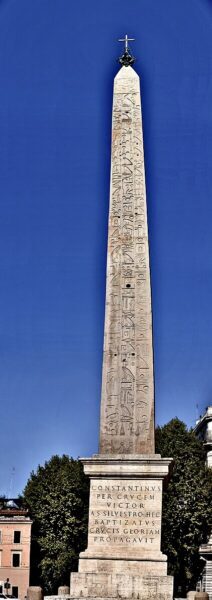
The Piazza Laterano obelisk. Rolfcosar, CC BY-SA 4.0, Wikimedia Commons
The last Egyptian obelisk to find its way to Urbs Aeterna did so under the direction of the Emperor Constantius, in A.D. 357. The inscriptions carved upon this massive monolith (108 feet tall and weighing over 400 tons) refer to the time of Pharaoh Thotmes IV, whose reign began in 1565 B.C. Thus it is quite possible that Moses beheld and admired it standing in front of the Temple of the Sun in Thebes. In A.D. 1588 it was hauled from its original Roman site, the Circus Maximus, down the narrow streets past the Church of St. Gregory the Great and around the gutted shell of the Flavian Amphitheater – more commonly known as the Colosseum – to the Piazza Laterano, near the side entrance to the Basilica of St. John. 3,500 years ago it had slumbered on in the sultry quiet languor of Theban afternoons. In our madcap early Twenty First Century, it now looks down daily at uncountable numbers of honking Fiats that scurry in kamikaze-like fashion around its base.
Over on the Coelian Hill, a public park called the Villa Coelimontana houses an obelisk, but only a small part of it hails from Egypt. Yet the park merits a visit for its stupendous terrace with a superb vista and two long avenues lined with helm oaks and boxwood that provide lovely outdoor shady galleries. A perfect oasis in the summer for a picnic lunch in the cool air amid multi-colored flower displays.
Not to be overlooked is yet another monument from Cleopatra’s land. Right outside Stazione Termini, the city’s modern railroad station, is yet one more authentic obelisk of Ramses the Great, centering the vast Piazza dei Cinquecento named for the five hundred Italian soldiers killed at Dogali in 1887, as mentioned on the inscription of the tastefully executed pedestal. On the four sides of the 19 foot high obelisk are hieroglyphics in a fine state of preservation. An early twentieth century classicist translates one side for us: “Ramses, loved by Ammon from Heliopolis, the Seat of Splendor; Lord of the Diadems, loved by the god Tum, Lord of Heliopolis.”
……….
Though all of this was part of the legacy of Imperial Rome, the modern capital had something to say about the subject of obelisks. There are many imitations, not of Aswan granite but of various types of “homegrown” stone from myriad quarries across Italy: Travertine from the Rome outskirts, Carrara marble from the hills of Tuscany, and a pinkish granite from the Alpine heights of Baveno that overlook the dreamy Lago Maggiore way up north in the region of Piemonte. From the last locale, in 1842, Alessandro, scion of the patrician Torlonia family, ordered two, thirty-meters tall, obelisks to be hewn and transported, at great expense, via roads, rivers, and the Adriatic Sea, to the Abruzzo region, thence to Roma Aeterna. These stone wonders the loyal son had installed in the lush gardens of the Villa Torlonia, dedicating them to the memory of his pater and mater.
In 1959 the city government paid high, very high, i.e., tribute to the late, great Guglielmo Marconi with a concrete obelisk 147 feet tall, which was veneered with 92 marble panels of basreliefs, showing the life and times of the genius. It reposes on the island of a roundabout in EUR, just a few miles west of the ancient center of Rome.
In anticipation of the 1960 Olympic Games to be hosted by Rome, Il Duce had built, at the upper bank of the Tiber, a sprawling sports complex, at the front entrance of which stood, and still stands, an impressive 57 feet tall obelisk of Carrara Marble, which on its monumental base soars to twice that height, with finely engraved letters in vertical order that spell out; MUSSOLINI DUX.
Then there is the elegant boulevard that leads straight from the river to St. Peter’s Basilica, the Via della Conciliazione, built from 1929 to 1939 as a gift from the Italian state to the Vatican to commemorate the Reconciliation between the two with the signing of the Lateran Concordat, which resulted in the new autonomy and authority of the Pope over his new very miniature country. Just in time for the Jubilee Year of A.D. 1950, the broad thoroughfare, just short of a half mile long, was spruced up with new lamp posts lining each side. These were hewn in obelisk form, each with an old fashioned lantern topping it off. Again a touch of Egypt in Rome, the Nile once more flowing into the Tiber.
Whatever else can be said about the Romans, they were great adapters of the lands they conquered. They obtained the idea of domes from the Etruscans, of columns from the Greeks, of obelisks from the Egyptians. (There is even a pyramid in Rome!)
……….
Now back to the world’s most exquisite exclamation point: the obelisk in St. Peter’s Square. As mentioned at the start, this imported monument’s first site in Rome was the dividing island of the horse- racing stadium in the Vatican fields. Though the arena eventually disappeared over the centuries, the obelisk somehow survived the barbarian invasions and remained standing in the original spot. In 313 this public land was given to Pope Miltiades by Constantine. On these 108 acres the Vatican we know today, as the seat of the Catholic Church, evolved. In 1586 Pope Sixtus V ordered the “trophy” moved about 300 meters to the center of St. Peter’s Square.
By this time, however, the technique and know-how of such a task was still shaky and uncertain at best. Sixtus turned to the architect Fontana to supervise this daunting, dangerous, and risky engineering feat. With beams, ropes, and scaffolding, along with windlasses, hundreds of horses, and a thousand or so laborers, the unwieldy 380-ton stele was, over the course of weeks, successfully removed from its base and towed ever so slowly on a flatbed ‘truck’ to its new position.
All that was left was the need to figure out a safe way to raise it back upright. After days of planning, the date was set for the installation. This project drew vast crowds of curious Romans and tourists to the site. Anticipating this, the Pope had forewarned would-be spectators, via signs all around town, that strict silence was to be observed so that the workers would not be distracted and could clearly hear Fontana’s directions. And … anyone uttering a single word would be put to death.
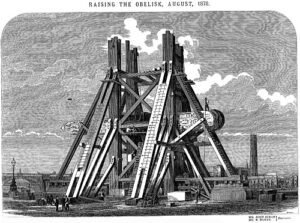
Raising an obelisk. Drawing. Public Domain, Wikimedia Commons
Back to work went the ropes, the horses, the windlasses, and the workmen to ease the obelisk into an upright stance on a new pedestal. When the granite giant reached upward to about a 45 degree angle, however, those in attendance froze in horror as the ropes began to give off smoke from all the stress and friction, and stretch out near to the point of snapping. Everything came to a standstill for hours as the obelisk teetered on the brink of thundering down and shattering into a million pieces. A sailor in the crowd, who knew how to deal with ropes from his years on sailing vessels shouted: “Acqua alle funi!” – pour water on the ropes. He was at once arrested but Fontana thought the suggestion worth the risk and ordered buckets of cold water from a nearby aqueduct to be splashed up and down the smoking straining cables.
It worked! Pope Sixtus was delighted and, of course, immediately pardoned the sailor, named Bresca, promising him whatever reward he desired, The hero of the day said that his family had property in Bordighera, a town on the Italian riviera, a region that abounded in palm trees, and that his relatives would all love the honor of supplying the palm leaves for Palm Sunday services at St. Peter’s. This request was granted. To this day the Bresca family’s descendants still have that privilege.
……….
Across the ages these amazingly durable and resilient granite shafts have changed their religious affiliation three times. They came into existence honoring the deities of Egypt, especially the Sun god. In time they switched their homage to deified Roman rulers. Today, each crowned with a cross, proclaims, in eloquent silence, the triumph of Christianity over its persecutors. In a city chock full of antiquities, it can rightly be said that in all of Eternal Rome, the most eternal things are the monuments from Egypt. The Roman Colosseum is approaching its 2000th birthday but is merely a decrepit shell of its former self, while the Egyptian obelisk in Piazza Laterano, reaching 108 feet into the blue, is nearly twice that age but looks to be still in the prime of life, as do its granite siblings throughout town.
Cover Image, Top Left: The obelisk of St. Peter’s Square. Walkerssk, Pixabay
________________________
Advertisement
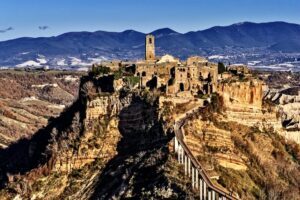
EXPLORE THE ANCIENT ETRUSCANS IN PERSON!
Experience a unique, up-close-and-personal hike among ancient hilltop towns in central Italy. You will walk the sensational countryside of the regions of Umbria and Tuscany, soaking in important sites attesting to the advanced Etruscan civilization, forerunners of the ancient Romans; imposing architectural and cultural remains of Medieval Italy; local food and drink; and perhaps best of all — spectacular scenic views! Join us in this collaborative event for the trip of a lifetime!

